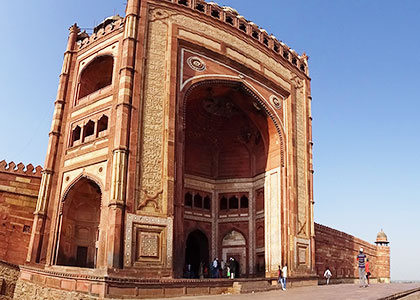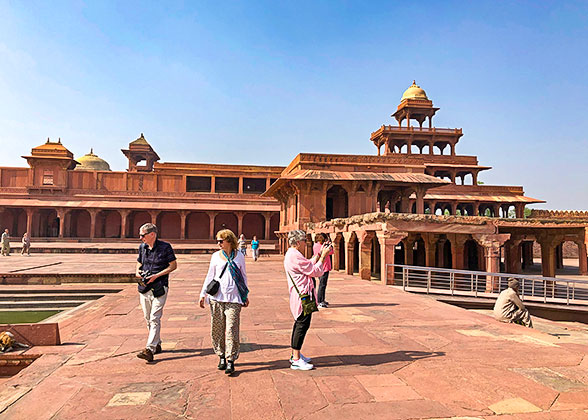Buland Darwaza (Gate of Victory) in Agra
While entering Fatehpur Sikri, you are first greeted with the magnificent Buland Darwaza (Gate of Victory). The opulent structure gives you a faint idea regarding what to expect inside the grand citadel. The towering gateway was built to commemorate Akbar’s win over Gujarat. Close to the city of Agra (well-known among tourists for being the home to Taj Mahal), the huge structure showcases the artistic bent of this celebrated empire.One of the tallest structures in the world while entering the Fatehpur Sikri, you will be able to spot Buland Darwaza from afar. Built-in 1601, the monument displays some of the most stunning features of Indian architecture, with subtle Persian elements. Decorated with stunning Islamiccalligraphy, the Buland Darwaza is watching over time for centuries.

|
Keynotes on Buland Darwaza (Gate of Victory)
Opening time: 8:00am to 7:00pm
Ticket Fee: Rs.750 for foreignersBuilt on: 1601
Built by: Emperor Akbar to commemorate the victory over GujaratLocated at: Dadupura, Fatehpur Sikri, Uttar Pradesh 283110
Architecture: Mostly Indian, with elements of PersianBrief History about the Mughals and Fatehpur Sikri
The Mughal Empire, established in the early 16th century by Babur, was a dominant dynasty of India. They ruled over the country over two centuries, revolutionized the politics, religion, culture, and other aspects of the society made important contributions towards military sciences and added kebabs into the Indian gastronomy.Babur, a warrior chieftain, defeated the then ruler of Delhi (Ibrahim Lodhi) and founded the empire. However, the Mughal Empire entered its glorious phase with Akbar, the grandson of Babur and the third ruler of the dynasty. Later his (Akbar’s) grandson took this empire to its peak.
During the reign of Akbar, the empire extended itself and annexed several neighboring kingdoms including Gujarat, and Bengal. To commemorate his win over these territories, Akbar built the soaring victory gateway, Buland Darwaza.
The 53.63-meter (176ft) high gateway is one of the main entrances to the stunning Jama Masjid at Fatehpur Sikri. The main gateway is decorated with verses from the Quran, engraved in delicate Naskh calligraphy, which is very soothing to the eyes. Not many are aware, but Buland Darwaza was never part of the original plan for Fatehpur Sikri. The arching gateway was erected by Akbar after his victory over the rulers of Khandesh (Gujarat).
The Architecture of the Gateway
Built from red sandstone, the Buland Darwaza (Gate of Victory) is decorated with white and black marble. The gateway is built symmetrically and topped with the chhatris (free-standing kiosks). The terraced gallery on the top of the gateway, built as buckler-battlements, was installed for protecting the citadel from outside attack.Located on Southern Entrance of Fatehpur Sikri, the visitors have to climb a long flight of stairs, totaling 42 steps, to enter the gateway. The steep steps give the tower an illusion of additional height; making it look taller although it is already 40m (131ft) in length.
The Buland Darwaza is octagonal, with two small wings attached on its either side. However, the star of the architecture of this gigantic gateway has to be the principal arch, broken into multiple tiers.
Inlaid work on the backdrop of marble panels has been used to decorate the victory gate. Interestingly, there is a Persian inscription of the eastern archway of the monument, which announces Akbar’s victory over his enemies. Apart from that, a declaration on the central wall of the Buland Darwaza illustrates the emperors’ religious openness.
Some Stunning Facts about Buland Darwaza
Here are some of the interesting facts about Buland Darwaza (Gate of Victory):
1. The gateway is 54 meters in length from the ground, making it one of the tallest gateways in the world.2. The architecture of the structure is a mix of Indian and Persian architecture.
3. Buland Darwaza is an opens up to marble-clad Jama Masjid and tomb of Salim Chisti. The inlaid work and the chhatris were inspired by Indian architectural elements
4. Central face of red sandstone gateway describes Akbar’s religious opennessMust Visit Attractions While Touring Fatehpur Sikri
The Buland Darwaza (Gate of Victory) is an important section of Fatehpur Sikri, however, that is not all. In reality, the citadel is filled with an opulent monument that reveals the grand artistic gestures of the Mughal’s. Regarded as a UNESCO World Heritage Site, Fatehpur Sikri is an important tourist attraction. Here are some of the important sections of this stunning citadel:Tomb of Salim Chisti
The tomb of Salim Chisti is probably the first thing that comes under the eyesight after passing through Buland Darwaza. Stunning white marble tomb, against the red sandstone backdrop, is a glorious sight. According to popular narratives, Sufi saint assured the then childless Akbar that heirs would be born to the emperor. After the saint’s death, Akbar built this glorious tomb in honor of the saint.The main structure is decorated with delicate inlaid work, which gives this monument a spiritual feel. A wooden canopy, decorated with stunning mother of pearls, welcomes devotees from all over the world.
Diwan-i-Aam
Diwan-i-Aam was the hall of public audience, where the emperor held his public meetings. It is a multi-layered structure, with a pavilion (Takht-i-Murassa) on the higher floor meant for the emperor to sit.One can imagine people gathering in the hallway of Diwan-i-Aam after passing through Buland Darwaza (Gate of Victory).
Diwan-i-Khas
This structure was meant for the private audience. Members of the royal court gathered here to discuss private affairs. Floral designs and geometrical patterns enhance the beauty of this building.Panch Mahal
An important structure of Fatehpur Sikri is the Panch Mahal. Entirely columnar structure of the building, reminiscing Buddhist architecture, has five levels. Close to the women’s quarters or zenana, the building was used for entertainment purposes. The columns of the structure were covered with screens so that aristocratic women could enjoy the cool summer breeze without being seen.The Fatehpur Sikri, Agra Fort, and Taj Mahal are popular landmarks of Agra, which attracts millions of tourists every year. The grand building represents the beauty of the Mughal architecture and the stunning part of India.




